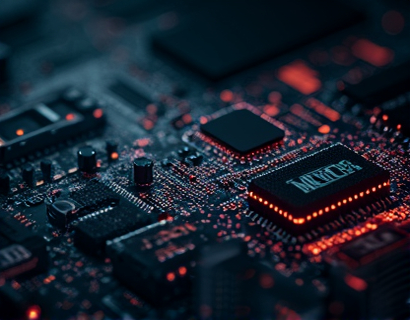Advanced Layer 2 Solutions: Revolutionizing Blockchain Scalability and Efficiency for EVM-Enabled Development
In the rapidly evolving landscape of blockchain technology, scalability and efficiency have emerged as critical challenges for developers, especially those working with Ethereum Virtual Machine (EVM)-enabled platforms. The inherent limitations of Layer 1 blockchains, such as limited transaction throughput and high gas fees, have spurred the development of advanced Layer 2 solutions. These solutions aim to enhance scalability, security, and efficiency, enabling the creation of faster, more secure, and cost-effective decentralized applications (dApps). This article delves into the transformative impact of advanced Layer 2 solutions on EVM-based blockchain development, providing insights for blockchain developers and innovators.
Understanding Layer 2 Solutions
Layer 2 solutions refer to technologies built on top of existing blockchain networks (Layer 1) to improve performance and reduce costs. Unlike Layer 1 upgrades, which involve modifying the core protocol, Layer 2 solutions operate within the existing framework, offloading some of the computational and transactional load. This approach allows for greater flexibility and faster implementation without the need for consensus among all network participants.
For EVM-enabled blockchains, Layer 2 solutions are particularly crucial. The EVM, while powerful, has limitations in terms of scalability and cost efficiency. Transactions on the EVM can be slow and expensive, especially during peak times. Layer 2 solutions address these issues by processing transactions off the main chain, thereby reducing congestion and lowering fees. This not only enhances user experience but also opens up new possibilities for dApp development.
Key Advanced Layer 2 Solutions
Several advanced Layer 2 solutions have gained prominence in the blockchain ecosystem, each offering unique benefits and use cases. Some of the most notable include state channels, sidechains, and rollups.
State Channels
State channels allow multiple parties to conduct a series of transactions off the main blockchain, with the final state being submitted to the blockchain once the channel is closed. This method significantly reduces the number of transactions recorded on the main chain, thereby lowering fees and increasing transaction speed. State channels are particularly useful for applications requiring frequent and small transactions, such as gaming and micropayments.
For EVM-based development, state channels can be implemented using smart contracts that manage the opening, closing, and state transitions of the channel. This approach ensures security and interoperability with the main chain, allowing developers to leverage the benefits of Layer 2 while maintaining the integrity of the EVM ecosystem.
Sidechains
Sidechains are independent blockchains that are linked to the main blockchain, allowing assets to be transferred between the two. This setup enables sidechains to operate with different consensus mechanisms and rules, optimizing for specific use cases. For EVM-based platforms, sidechains can offload heavy computational tasks, such as complex smart contracts, to a more efficient environment.
Developers can create sidechains that are compatible with the EVM, ensuring seamless integration and asset portability. This flexibility allows for the development of specialized dApps that can benefit from the optimized performance of the sidechain while still being part of the broader EVM ecosystem.
Rollups
Rollups are one of the most promising Layer 2 solutions for scalability. They come in two main types: Optimistic Rollups and ZK Rollups.
Optimistic Rollups bundle multiple transactions into a single transaction on the main chain, with a challenge period allowing anyone to dispute the validity of the transactions. If no challenge is raised, the transaction is confirmed. This method significantly reduces the load on the main chain, leading to faster transaction times and lower fees.
ZK Rollups, on the other hand, use zero-knowledge proofs to bundle and verify transactions off-chain, submitting a compact proof to the main chain. This approach offers even higher scalability and security, as the main chain only verifies the proof rather than the entire set of transactions.
For EVM-based development, rollups provide a robust solution for building scalable dApps. Developers can deploy smart contracts on the rollup layer, benefiting from reduced gas costs and faster transaction confirmations, while still leveraging the security and functionality of the EVM.
Enhancing Security and Efficiency
One of the primary concerns with Layer 2 solutions is ensuring the security and reliability of off-chain transactions. Advanced Layer 2 technologies employ various mechanisms to maintain the integrity of the blockchain ecosystem.
For state channels, security is ensured through cryptographic protocols that validate the state transitions. Smart contracts manage the opening and closing of channels, ensuring that only authorized parties can interact with the channel. This minimizes the risk of fraud and ensures that the final state accurately reflects all transactions.
Sidechains enhance security by using their own consensus mechanisms, which can be tailored to specific requirements. Cross-chain bridges, which facilitate asset transfer between the main chain and sidechains, are designed with robust security measures to prevent double-spending and other vulnerabilities.
Rollups, particularly ZK Rollups, offer strong security guarantees through the use of zero-knowledge proofs. These proofs allow the main chain to verify the validity of off-chain transactions without needing to process the entire set of data. This not only enhances security but also improves the overall efficiency of the network.
Moreover, advanced Layer 2 solutions often incorporate redundancy and fault tolerance mechanisms. For instance, multiple validators can be involved in the processing and verification of transactions, ensuring that the system remains resilient even in the face of potential failures or malicious attacks.
Driving Innovation in EVM-Based Development
The integration of advanced Layer 2 solutions with EVM-based blockchains is driving significant innovation in the blockchain development space. By addressing the scalability and efficiency challenges, developers can focus on building more complex and feature-rich dApps.
One of the key benefits is the reduction in gas costs. With Layer 2 solutions offloading a significant portion of the transaction load, gas fees are dramatically reduced. This makes it more accessible for developers to deploy and maintain dApps, fostering a more vibrant and diverse ecosystem.
Additionally, the increased transaction throughput enables the creation of real-time applications that were previously impractical on Layer 1 blockchains. For example, decentralized finance (DeFi) protocols, non-fungible token (NFT) marketplaces, and decentralized gaming platforms can now operate with higher performance and lower costs.
For developers, the ease of integrating Layer 2 solutions with EVM-based platforms is a significant advantage. Many Layer 2 protocols provide developer-friendly tools and libraries, simplifying the process of building scalable dApps. This accessibility encourages more developers to explore and contribute to the blockchain space, driving further innovation and adoption.
Case Studies and Real-World Applications
Several projects and platforms have successfully leveraged advanced Layer 2 solutions to enhance their EVM-based dApps. One notable example is the use of Optimistic Rollups by the Scalar network, which has enabled the creation of high-performance DeFi protocols with significantly lower fees.
Another example is the implementation of ZK Rollups by the Polygon network, which has facilitated the deployment of complex NFT marketplaces and gaming platforms. These platforms benefit from faster transaction times and reduced costs, enhancing user experience and driving engagement.
These case studies demonstrate the practical benefits of advanced Layer 2 solutions in real-world scenarios. By optimizing scalability and efficiency, developers can build more robust and user-friendly dApps, pushing the boundaries of what is possible on EVM-based blockchains.
Future Prospects and Challenges
While advanced Layer 2 solutions have shown great promise, there are still challenges to overcome to fully realize their potential. One key area is interoperability between different Layer 2 protocols and Layer 1 blockchains. Ensuring seamless asset and data transfer across various layers is crucial for building a cohesive and interconnected blockchain ecosystem.
Another challenge is the complexity of implementing and managing Layer 2 solutions. Developers need to have a deep understanding of both the Layer 2 technology and the underlying EVM-based platform. Educational resources and community support are essential to bridge this knowledge gap and encourage wider adoption.
Looking ahead, the development of more sophisticated Layer 2 solutions is expected to continue. Innovations such as layer-up solutions, which combine multiple Layer 2 technologies, and the integration of Layer 2 with emerging blockchain features like sharding, promise to further enhance scalability and efficiency.
In conclusion, advanced Layer 2 solutions are revolutionizing EVM-based blockchain development by addressing scalability and efficiency challenges. By reducing costs and increasing transaction throughput, these solutions enable the creation of more sophisticated and accessible dApps. As the ecosystem continues to evolve, developers and innovators will play a crucial role in shaping the future of blockchain technology.










































